“Rarely can a response make something better. What makes something better is connection”
Category: Personal World
Situational Morality
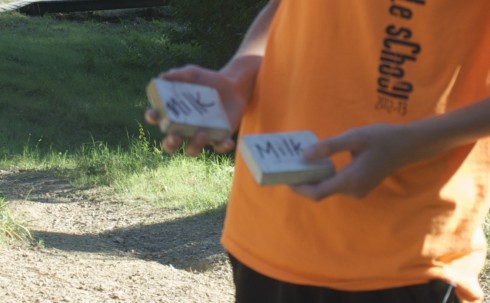
“Stealing is always wrong,” versus, “If I were starving, I’d steal from A. no problem.” That was the gist of our discussion the evening after spending a night in the Heifer’s global village.
The “slum dwellers” had started off with very little in the way of resources, and two of them decided, on their own initiative, to steal some “milk” for their “baby” from the “Guatemalans” who were significantly better off. However, the rest of the slum group found out there was quite a bit of dissension in the ranks.
The thieves also stole most of the rest of the milk while they were at it to trade with the other groups. Their logic — I think — was that since all the groups needed milk, and they would be distributing it, then everyone could ultimately get what they needed, while if they had not stolen the milk then the slums might not have gotten any.
The reverberations throughout the all the houses in the global village were profound, however, lots of distrust and animosity developed that had not been there before. It made it more difficult for the slums to get the other resources that they needed, because the other groups could not trust their motivations.
In fact, the other groups ended up having a harder time trading and communicating with each other because of the breakdown in trust. One other group started to lie about what they had and did not have. At first this was to deter theft, but they quickly realized that they could use this to their advantage.
Interestingly, it all worked out in the end. The slum dwellers felt guilty enough to exhibit real concern when they thought their plan had gone wrong and one of the other groups did not have any milk. The Guatemalans ended up with enough resources of their own to have a decent dinner, and even passed on some of their left-over vegetables to the slums. The slums invited everyone over to the “christening” of their water-balloon baby and everyone came. And we got to have a richer discussion than if everyone had just been nice to everyone else.
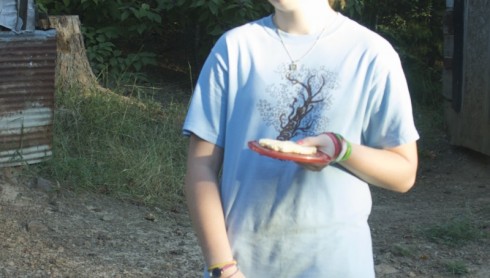
Empathy
Empathy is seeing the world through the eyes of others. Adolescents tend to look inward, not outward, but empathy is the basis of morality, so exposure to others and other points of view is an important element of their education. I find the following video interesting (much like the Bright Eyes video) because in its hints at so many hidden messages and meanings. It provokes thoughts about who these kids are, what is life like for them, and how do they see the world.
Note: David Brooks argues that while empathy orients one toward moral behavior, it’s really sacred moral codes that convert that orientation into action.
Journaling on the River

It was not all dark and stormy on our Outdoor Education canoe trip. The first afternoon was warm and bright; the first splashes of fall color spicing up the deep, textured greens of the lush, natural vegetation. It was so nice that, in the middle of the afternoon, we took a short break, just shy of half an hour, to reflect and journal.

Our guides chose to park our boats at a beautiful bend in the river. Most of my students chose to sit in the canoes or on the sandy point-bar on the inside of the meander, but a few to be ferried across the river to a limestone cliff on the cut-bank of the curve. An enormous, flat-topped boulder had fallen into the water to make a wonderfully picturesque site for quiet reflection for two students. A third student chose to sit in a round alcove sculpted by the solution weathering of the carbonate rock itself.
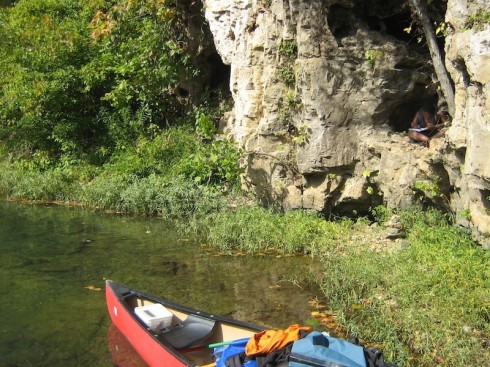
The cut-bank of a river’s meander tends to be deeper than the inside of the curve, because the water is forced to flow faster on the outside of the bend where it has more distance to travel. This proved to be quite convenient for my students, because it meant that the stream-bed around their boulder was deep enough that they could jump into the water after the hot work of writing while sitting in the sun. And they did.

(From our Eminence Immersion)
Control your Destiny: How the Adolescent Brain Works
During your adolescence, which lasts from your early teens into your 20’s, the brain changes rapidly, you develop new abilities and capacities, and the habits of mind and skills you develop will last long into adulthood.
Abilities: The last part of the brain to develop is the Frontal Lobe. It’s responsible for reasoning and judgement — aka Executive Function. So, it’s somewhat understandable that teens often have poor impulse control — their Frontal Lobe (the prefrontal cortex in particular) is still developing.
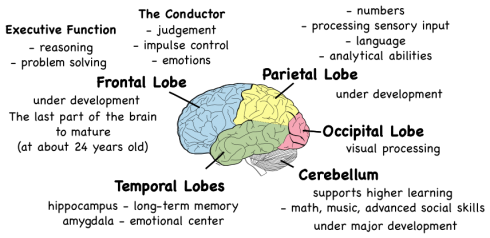
However that’s not an excuse. It is essential for adolescents to be held to account, because it’s only by practicing responsibility that they get to learn how to use their Executive thinking skills.
Because that’s how we learn — by practicing.
When we’re learning something new, brain cells, called neurons, reach out and connect to form networks. As we practice and focus on specific things — certain patterns of movement or certain ways of thought — some of the unused connections get pruned away, while others become stronger. The axons that connect the most-used pathways get coated in myelin, which acts as an insulator to make sure signals can pass quickly and efficiently.
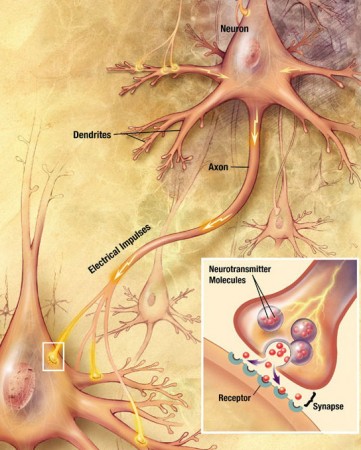
By reorganizing the connections between brain cells, the brain learns and becomes better at what you’re practicing. Thus we gradually transition from novices to experts.
However, there is a cost.
Making strong pathways makes for quicker thinking about the things we’ve practiced, but makes our brains somewhat less flexible at learning new things. We develop habits of mind that stay with us for a long time.
Some of those habits we might not actually want to keep; and there’s also the possibility that we might not develop some habits of mind that we really would like to have.
The development of the frontal lobe during adolescence opens a window of opportunity for learning good judgement/executive function, but it does not mean we actually will learn it. We need to actually practice it.
So, if you would like to know yourself, want to be able to control yourself, and, especially, want to shape the future person you will become, then you’re going to have to figure out: which habits of mind you want to be practicing and which ones you don’t.
On the Loss of Boredom in the Internet Age
I remember, as a child, being bored. I grew up in a particularly boring place and so I was bored pretty frequently. But when the Internet came along it was like, “That’s it for being bored! Thank God! ….”
It was only later that I realized the value of being bored was actually pretty high. Being bored is a kind of diagnostic for the gap between what you might be interested in and your current environment. But now it is an act of significant discipline to say, “I’m going to stare out the window. I’m going to schedule some time to stare out the window.”
— Clay Shirky in an interview with Sonia Saraiya on Findings.com
We need a little boredom, to let our minds wander and thus to spur creativity.
Zoë Pollock, on The Dish, highlights the thoughts of Clay Shirky and the response of Nicholas Carr on loss of space for boredom in the internet age.
The Elements of Creativity
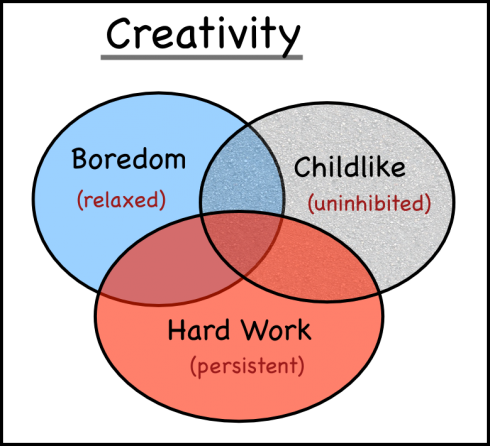
Jonah Lehrer’s has an excellent interview on Fresh Air about his new book on how creativity works, called Imagine.
There are three key components:
- Relaxed state of mind: Like when you’re in the shower and your mind is free to wander. It’s another reason not to be afraid of a little boredom, and setting aside personal time time in the day.
- Hard work: But the relaxed mind needs to have something to work with, and that’s all the hard work that came before. When you’re relaxed the mind processes things in different ways, it mulls over the things you’ve been thinking of, and makes unexpected connections.
- Uninhibited, childlike perspective: You need to allow your brain the opportunity to be creative. All the hard work requires good focus and persistence; things the pre-frontal cortex develops the ability to do (and something we train it to do) during adolescence. But the ultimate, creative insight often requires you to turn off that part of the brain so you can thing uninhibited, creative thoughts.
The Ingredients of “Character”
Some key performance-character strengths:
zest, grit, self-control, social intelligence, gratitude, optimism and curiosity.
— Tough (2011): What if the Secret to Success Is Failure? in The New York Times’ Education Issue
Paul Tough’s thought provoking article is a great overview of some of the recent research on character, and discusses a few attempts to instill character building into school.
Levin [co-founder of the KIPP network of charter schools ] noticed that … the students who persisted in college were not necessarily the ones who had excelled academically at KIPP; they were the ones with exceptional character strengths, like optimism and persistence and social intelligence. They were the ones who were able to recover from a bad grade and resolve to do better next time; to bounce back from a fight with their parents; to resist the urge to go out to the movies and stay home and study instead; to persuade professors to give them extra help after class.
— Tough (2011): What if the Secret to Success Is Failure?
Much of the work on character is based on the universal character characteristics identified in the book Character Strengths and Virtues: A Handbook and Classification (Peterson and Seligman, 2004) and the research of Angela Duckworth (her research page is a good place to find copies of her publications).
Duckworth’s Grit Scale, seems to be a remarkably good predictor of GPA, and perhaps more interestingly, corresponded inversely to the number of hours of television students watched: “gritter” students did better in school and watched less TV.
Among adolescents, the Grit–S [short Grit Scale] longitudinally predicted GPA and, inversely, hours watching television. Among cadets at the United States Military Academy, West Point, the Grit–S predicted retention.
— Duckworth and Quinn (2009): Development and Validation of the Short Grit Scale (Grit–S)
The grit survey would probably be a useful addition to the Personal World curriculum.
One interesting application discussed in the article is at the KIPP middle schools in NYC. There they issue a Character Report Card and integrate discussion of character into all the classes: a language class might talk about how much self control the protagonist in a novel has and how that works out for them.
I’d be extremely reluctant to have to grade my students on twenty four character traits. While it might be a useful rubric to have and discuss and build on students’ positive self-conceptions, I fear that it might also significantly reinforce the negative conceptions as well.
Imbuing a language of character as a subtext of the curriculum seems like a great idea however.
Performance vs. Moral Character
One important critique of much of this work is that it focuses on “performance” character, the character traits that predict high achievement, rather than “moral” character which focuses on the ability to work well with others.
These two perspectives on the same character traits need careful attention. From a performance perspective, social intelligence, can be seen as a way of getting ahead – something that is somewhat manipulative, but from a moral perspective, social intelligence is intrinsically beneficial to the person and the society around them.
And perhaps this is the biggest problem with performance-character. It is extrinsically motivated: do this and you will get this reward. The intrinsic nature of moral-character seems much more in line with a progressive approach to teaching. Certainly, much care should be taken in how we think about and include character building in education.
The Character Education Partnership has a number of lesson plans and best practices for all grade levels, that focus more on moral character.
Giving Students the Opportunity to Fail
Finally, Tough talks about the fact that students need the time and space to explore, try difficult things, and to fail, in order to really build character.
The idea of building grit and building self-control is that you get that through failure, and in most highly academic environments in the United States, no one fails anything.
— Dominic Randolph (2011) in Tough (2011): What if the Secret to Success Is Failure? in The New York Times’ Education Issue
This is tied into the central theme of the movie Race To Nowhere and the book The Price of Privilege, that argue that, for many affluent students, the stress of excessively high academic expectations are having some seriously negative effects.
People with self-respect have the courage of their mistakes. – Joan Didion (1961), via Word on the Street (2010)
(hat tip to Ms. D. for the link to the article)

